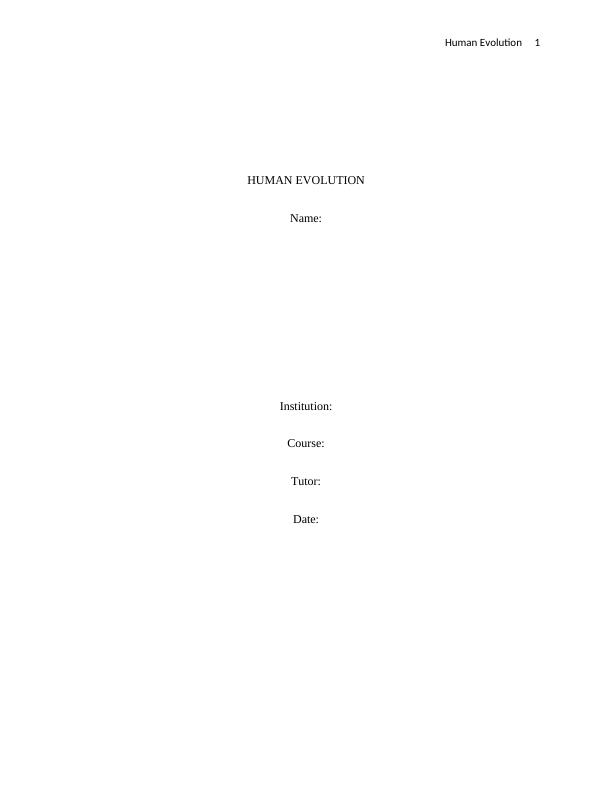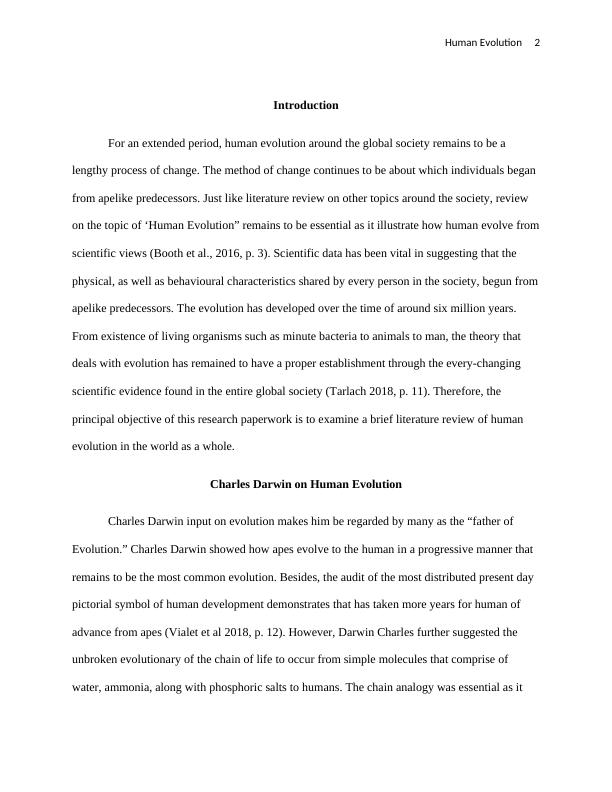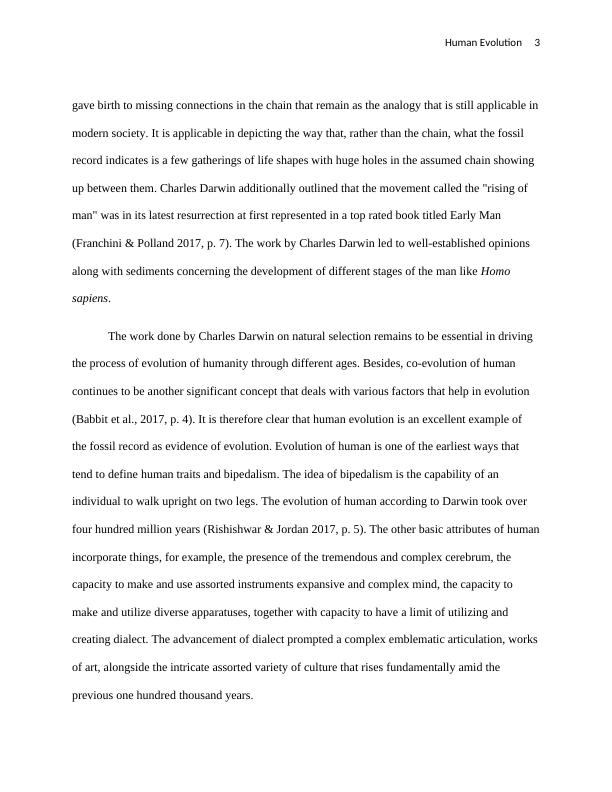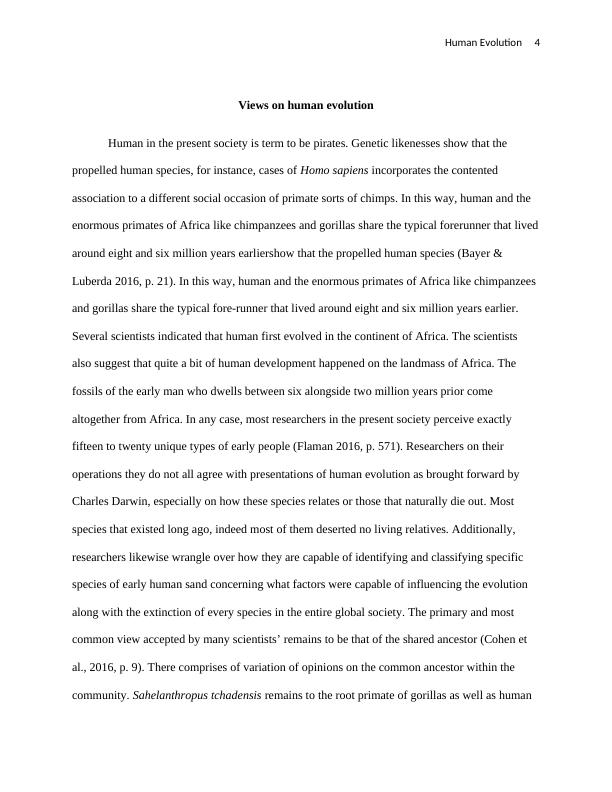Human Evolution: A Brief Literature Review
12 Pages3244 Words146 Views
Added on 2023-06-13
About This Document
This research paper examines a brief literature review of human evolution in the world as a whole. It covers Charles Darwin's input on evolution, views on human evolution, paleoanthropology, brain of human, and more.
Human Evolution: A Brief Literature Review
Added on 2023-06-13
ShareRelated Documents
Human Evolution 1
HUMAN EVOLUTION
Name:
Institution:
Course:
Tutor:
Date:
HUMAN EVOLUTION
Name:
Institution:
Course:
Tutor:
Date:

Human Evolution 2
Introduction
For an extended period, human evolution around the global society remains to be a
lengthy process of change. The method of change continues to be about which individuals began
from apelike predecessors. Just like literature review on other topics around the society, review
on the topic of ‘Human Evolution” remains to be essential as it illustrate how human evolve from
scientific views (Booth et al., 2016, p. 3). Scientific data has been vital in suggesting that the
physical, as well as behavioural characteristics shared by every person in the society, begun from
apelike predecessors. The evolution has developed over the time of around six million years.
From existence of living organisms such as minute bacteria to animals to man, the theory that
deals with evolution has remained to have a proper establishment through the every-changing
scientific evidence found in the entire global society (Tarlach 2018, p. 11). Therefore, the
principal objective of this research paperwork is to examine a brief literature review of human
evolution in the world as a whole.
Charles Darwin on Human Evolution
Charles Darwin input on evolution makes him be regarded by many as the “father of
Evolution.” Charles Darwin showed how apes evolve to the human in a progressive manner that
remains to be the most common evolution. Besides, the audit of the most distributed present day
pictorial symbol of human development demonstrates that has taken more years for human of
advance from apes (Vialet et al 2018, p. 12). However, Darwin Charles further suggested the
unbroken evolutionary of the chain of life to occur from simple molecules that comprise of
water, ammonia, along with phosphoric salts to humans. The chain analogy was essential as it
Introduction
For an extended period, human evolution around the global society remains to be a
lengthy process of change. The method of change continues to be about which individuals began
from apelike predecessors. Just like literature review on other topics around the society, review
on the topic of ‘Human Evolution” remains to be essential as it illustrate how human evolve from
scientific views (Booth et al., 2016, p. 3). Scientific data has been vital in suggesting that the
physical, as well as behavioural characteristics shared by every person in the society, begun from
apelike predecessors. The evolution has developed over the time of around six million years.
From existence of living organisms such as minute bacteria to animals to man, the theory that
deals with evolution has remained to have a proper establishment through the every-changing
scientific evidence found in the entire global society (Tarlach 2018, p. 11). Therefore, the
principal objective of this research paperwork is to examine a brief literature review of human
evolution in the world as a whole.
Charles Darwin on Human Evolution
Charles Darwin input on evolution makes him be regarded by many as the “father of
Evolution.” Charles Darwin showed how apes evolve to the human in a progressive manner that
remains to be the most common evolution. Besides, the audit of the most distributed present day
pictorial symbol of human development demonstrates that has taken more years for human of
advance from apes (Vialet et al 2018, p. 12). However, Darwin Charles further suggested the
unbroken evolutionary of the chain of life to occur from simple molecules that comprise of
water, ammonia, along with phosphoric salts to humans. The chain analogy was essential as it

Human Evolution 3
gave birth to missing connections in the chain that remain as the analogy that is still applicable in
modern society. It is applicable in depicting the way that, rather than the chain, what the fossil
record indicates is a few gatherings of life shapes with huge holes in the assumed chain showing
up between them. Charles Darwin additionally outlined that the movement called the "rising of
man" was in its latest resurrection at first represented in a top rated book titled Early Man
(Franchini & Polland 2017, p. 7). The work by Charles Darwin led to well-established opinions
along with sediments concerning the development of different stages of the man like Homo
sapiens.
The work done by Charles Darwin on natural selection remains to be essential in driving
the process of evolution of humanity through different ages. Besides, co-evolution of human
continues to be another significant concept that deals with various factors that help in evolution
(Babbit et al., 2017, p. 4). It is therefore clear that human evolution is an excellent example of
the fossil record as evidence of evolution. Evolution of human is one of the earliest ways that
tend to define human traits and bipedalism. The idea of bipedalism is the capability of an
individual to walk upright on two legs. The evolution of human according to Darwin took over
four hundred million years (Rishishwar & Jordan 2017, p. 5). The other basic attributes of human
incorporate things, for example, the presence of the tremendous and complex cerebrum, the
capacity to make and use assorted instruments expansive and complex mind, the capacity to
make and utilize diverse apparatuses, together with capacity to have a limit of utilizing and
creating dialect. The advancement of dialect prompted a complex emblematic articulation, works
of art, alongside the intricate assorted variety of culture that rises fundamentally amid the
previous one hundred thousand years.
gave birth to missing connections in the chain that remain as the analogy that is still applicable in
modern society. It is applicable in depicting the way that, rather than the chain, what the fossil
record indicates is a few gatherings of life shapes with huge holes in the assumed chain showing
up between them. Charles Darwin additionally outlined that the movement called the "rising of
man" was in its latest resurrection at first represented in a top rated book titled Early Man
(Franchini & Polland 2017, p. 7). The work by Charles Darwin led to well-established opinions
along with sediments concerning the development of different stages of the man like Homo
sapiens.
The work done by Charles Darwin on natural selection remains to be essential in driving
the process of evolution of humanity through different ages. Besides, co-evolution of human
continues to be another significant concept that deals with various factors that help in evolution
(Babbit et al., 2017, p. 4). It is therefore clear that human evolution is an excellent example of
the fossil record as evidence of evolution. Evolution of human is one of the earliest ways that
tend to define human traits and bipedalism. The idea of bipedalism is the capability of an
individual to walk upright on two legs. The evolution of human according to Darwin took over
four hundred million years (Rishishwar & Jordan 2017, p. 5). The other basic attributes of human
incorporate things, for example, the presence of the tremendous and complex cerebrum, the
capacity to make and use assorted instruments expansive and complex mind, the capacity to
make and utilize diverse apparatuses, together with capacity to have a limit of utilizing and
creating dialect. The advancement of dialect prompted a complex emblematic articulation, works
of art, alongside the intricate assorted variety of culture that rises fundamentally amid the
previous one hundred thousand years.

Human Evolution 4
Views on human evolution
Human in the present society is term to be pirates. Genetic likenesses show that the
propelled human species, for instance, cases of Homo sapiens incorporates the contented
association to a different social occasion of primate sorts of chimps. In this way, human and the
enormous primates of Africa like chimpanzees and gorillas share the typical forerunner that lived
around eight and six million years earliershow that the propelled human species (Bayer &
Luberda 2016, p. 21). In this way, human and the enormous primates of Africa like chimpanzees
and gorillas share the typical fore-runner that lived around eight and six million years earlier.
Several scientists indicated that human first evolved in the continent of Africa. The scientists
also suggest that quite a bit of human development happened on the landmass of Africa. The
fossils of the early man who dwells between six alongside two million years prior come
altogether from Africa. In any case, most researchers in the present society perceive exactly
fifteen to twenty unique types of early people (Flaman 2016, p. 571). Researchers on their
operations they do not all agree with presentations of human evolution as brought forward by
Charles Darwin, especially on how these species relates or those that naturally die out. Most
species that existed long ago, indeed most of them deserted no living relatives. Additionally,
researchers likewise wrangle over how they are capable of identifying and classifying specific
species of early human sand concerning what factors were capable of influencing the evolution
along with the extinction of every species in the entire global society. The primary and most
common view accepted by many scientists’ remains to be that of the shared ancestor (Cohen et
al., 2016, p. 9). There comprises of variation of opinions on the common ancestor within the
community. Sahelanthropus tchadensis remains to the root primate of gorillas as well as human
Views on human evolution
Human in the present society is term to be pirates. Genetic likenesses show that the
propelled human species, for instance, cases of Homo sapiens incorporates the contented
association to a different social occasion of primate sorts of chimps. In this way, human and the
enormous primates of Africa like chimpanzees and gorillas share the typical forerunner that lived
around eight and six million years earliershow that the propelled human species (Bayer &
Luberda 2016, p. 21). In this way, human and the enormous primates of Africa like chimpanzees
and gorillas share the typical fore-runner that lived around eight and six million years earlier.
Several scientists indicated that human first evolved in the continent of Africa. The scientists
also suggest that quite a bit of human development happened on the landmass of Africa. The
fossils of the early man who dwells between six alongside two million years prior come
altogether from Africa. In any case, most researchers in the present society perceive exactly
fifteen to twenty unique types of early people (Flaman 2016, p. 571). Researchers on their
operations they do not all agree with presentations of human evolution as brought forward by
Charles Darwin, especially on how these species relates or those that naturally die out. Most
species that existed long ago, indeed most of them deserted no living relatives. Additionally,
researchers likewise wrangle over how they are capable of identifying and classifying specific
species of early human sand concerning what factors were capable of influencing the evolution
along with the extinction of every species in the entire global society. The primary and most
common view accepted by many scientists’ remains to be that of the shared ancestor (Cohen et
al., 2016, p. 9). There comprises of variation of opinions on the common ancestor within the
community. Sahelanthropus tchadensis remains to the root primate of gorillas as well as human

End of preview
Want to access all the pages? Upload your documents or become a member.
